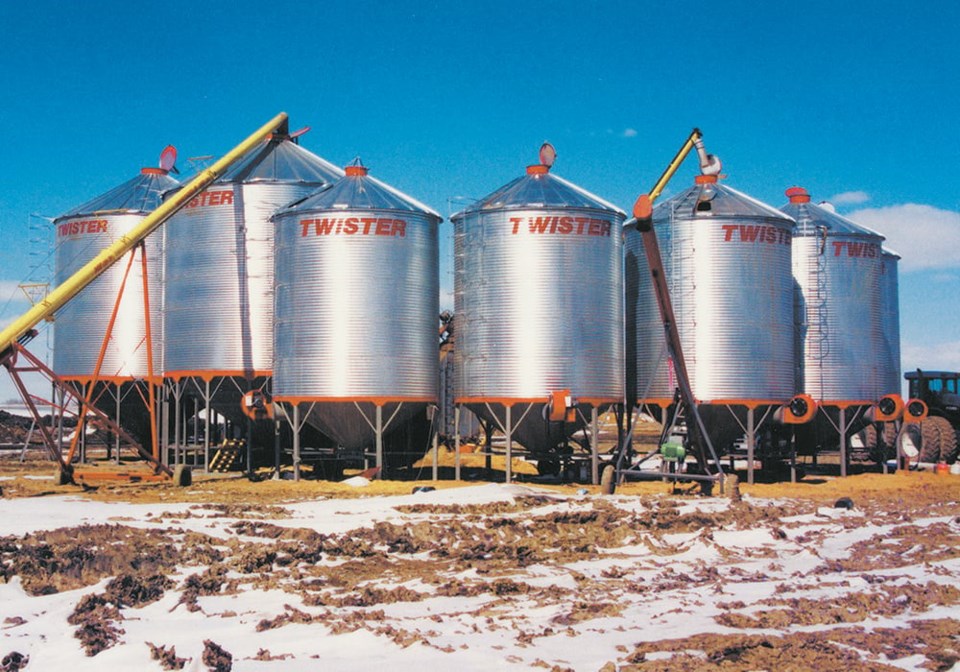WESTERN PRODUCER – With unusually high temperatures interrupted by two deep freezes, it’s been a challenging winter for grain storage on the Prairies and one requiring diligence to protect stored crop.
Anne Kirk, cereal crop specialist with Manitoba Agriculture, advises aeration and vigilant monitoring of bin moisture and temperature. The latter is particularly important when outside temperatures fluctuate.
“We have definitely heard of some issues with canola having some heating in the bin and some higher moisture zones,” Kirk said. “That’s something that farmers definitely need to be on the lookout for.”
Alberta is also experiencing higher spoilage risk, wrote Neil Blue, provincial government crops market analyst, in a recent news release.
“Several cases of spoiling crops have showed up lately, leading to marketing difficulty and large price discounts,” he said.
In contrast, Kim Stonehouse, crops extension specialist with the Saskatchewan agriculture ministry, reports that storage conditions have been “fairly normal” in her province this year.
Spoilage in bins is usually caused by moisture migration.
“In the fall and winter, grain in the bin cools because it’s colder on the edges,” Kirk said.
That cool air on the periphery of the grain then starts to settle.
“As it moves towards the floor of the bin and into the centre, (the air) becomes warmer because the grain on the inside of the bin is warmer, and then that warmer air becomes lighter.”
That warm air then reverses, rising in the centre of the bin before cooling again when it reaches cold grain near the surface.
“What results is an increase in moisture content near the surface, which can cause rapid grain spoilage.”
Grain and oilseeds will respire for a month or more after storage, noted Blue.
“This respiration can release moisture, which in turn can lead to spoilage. Dense crops like canola are particularly subject to storage problems, although all crops with moisture can spoil.”
Producers’ best bet is to aerate binned crops during the respiration period.
The basic moisture migration process and its management are the same even when it’s -40 C, said Blue, but the cold snap may have caused more migration.
“The colder January temperatures would further cool the outside portions of the stored crop, possibly leading to more moisture migration from the bottom-middle up towards the top, where that moisture would meet cold crop, possibly causing condensation there.”
Kirk also noted any sudden shift from springlike temperatures to bone-chilling cold should warrant a bin check.
“Do you have a high moisture zone? Is your grain kind of crusty on top, which indicates higher moisture? What temperatures are you going to add?”
Cycling grain or canola can equalize temperatures in the bin, she said.
“Especially for something like canola, take a load or part of a load out of a variety of canola bins to just check it and then cycle it through so you are mixing it up a bit and not creating those really high moisture results in the bin.”
Blue also recommended turning the crop by removing some from each bin, letting it sit on a truck for a day or two and then returning it to the bin. It’s better to do this during cold weather,
“If continued safe storage is questionable, it may be advisable to turn the grain again in the spring as the stored grain warms, or use the fan if the bin is equipped,” said Blue, adding that consistent monitoring is key.
“Many producers use in-bin monitoring systems to detect potential storage trouble. While lower than last crop year’s prices, crop prices are still historically high and worth protecting in storage.”
Monitoring can be also be done with a grain probe, said Kirk, although she cautioned producers to be thorough.
“We like to recommend probing all sides and the centre of the bin,” she said.
Stonehouse agreed that monitoring grain temperatures and quickly addressing any issues is always a good practice. Even grain that is not at a safe storage moisture content can have a long shelf-life as long as temperatures stay below 5 C, she noted. Beyond that, problems occur.
“If there is spoilage happening, it is possible that the grain did not cool to below zero degrees Celsius after harvest due to the unusually warm weather we had,” she said.
Although 10 percent moisture (the dry moisture standard for canola) is usually sufficient for marketing, its actual moisture in the bin should be lower, said Blue.
“Safe, longer-term storage moisture levels are below eight percent. If it is binned at high temperatures, canola can even spoil at six percent moisture,” he noted.
The Canadian Grain Commission outlines moisture standards for many grains. Buyer expectations also play a role.
“Certain markets or contracts may have different moisture level specifications than (the commission’s). For example, feed barley sold to a domestic feed user is commonly considered to be dry at 15 percent moisture or less,” said Blue.
Kirk also recommended using CGC resources.
“They have a lot of graphs on their website where you can plot out your initial moisture content of your grain and the temperature of the grain going in the bin.”




